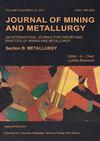Reduction behavior of iron in the red mud
IF 1
4区 材料科学
Q3 METALLURGY & METALLURGICAL ENGINEERING
Journal of Mining and Metallurgy Section B-Metallurgy
Pub Date : 2021-01-01
DOI:10.2298/jmmb210227039e
引用次数: 0
Abstract
Red mud or bauxite residue contains significant quantities of industrial metals such as Fe, Al and Ti, and rare earths such as Sc, Ce, and La. The authors performed a laboratory-scale project work dealing with stepwise recovery of valuable elements from two bauxite residues, namely Iranian red mud (IRM) and Turkish red mud (TRM). In the first stage, it was tried to recover iron which is present in large quantities in red mud. Two different methods have been investigated for this purpose: 1) solid state reduction followed by wet magnetic separation, 2) smelting. In the scope of this paper, some results of pyrometallurgical part of this project are presented. According to solid-state reduction experiments, it was found that more excess coal was needed for IRM (35%) than TRM (15%) to maximize iron reduction. Temperature had significant effect on the reduction process and metallization increased from about 70% to about 95% when the temperature was raised from 1000 to 1200?C. Metallization degree was reported to be slightly higher for IRM (96.2%) than TRM (94.1%). The results demonstrated that a high degree of iron metallization can be achieved regardless of the chemical and mineralogical composition of the bauxite residue sample.赤泥中铁的还原行为
赤泥或铝土矿渣含有大量的工业金属,如铁、铝和钛,以及稀土,如Sc、Ce和La。作者进行了一个实验室规模的项目工作,处理从两种铝土矿残留物,即伊朗赤泥(IRM)和土耳其赤泥(TRM)中逐步回收有价元素。在第一阶段,试图回收大量存在于赤泥中的铁。为此研究了两种不同的方法:1)固态还原,然后是湿式磁选,2)熔炼。在本文的范围内,介绍了该项目火法冶炼部分的一些成果。通过固态还原实验发现,为了最大限度地还原铁,IRM(35%)比TRM(15%)需要更多的多余煤。温度对还原过程有显著影响,当温度从1000℃升高到1200℃时,金属化率从70%左右提高到95%左右。金属化程度IRM(96.2%)略高于TRM(94.1%)。结果表明,无论铝土矿渣样品的化学和矿物组成如何,都可以实现高程度的铁金属化。
本文章由计算机程序翻译,如有差异,请以英文原文为准。
求助全文
约1分钟内获得全文
求助全文
来源期刊
CiteScore
2.00
自引率
40.00%
发文量
19
审稿时长
2 months
期刊介绍:
University of Belgrade, Technical Faculty in Bor, has been publishing the journal called Journal of Mining and Metallurgy since 1965 and in 1997 it was divided in two independent journals dealing with mining and metallurgy separately. Since 2009 Journal of Mining and Metallurgy, Section B: Metallurgy has been accepted in Science Citation Index Expanded.
Journal of Mining and Metallurgy, Section B: Metallurgy presents an international medium for the publication of contributions on original research which reflect the new progresses in theory and practice of metallurgy. The Journal covers the latest research in all aspects of metallurgy including hydrometallurgy, pyrometallurgy, electrometallurgy, transport phenomena, process control, solidification, mechanical working, solid state reactions, materials processing, surface treatment and relationships among processing, structure, and properties of materials.

 求助内容:
求助内容: 应助结果提醒方式:
应助结果提醒方式:


